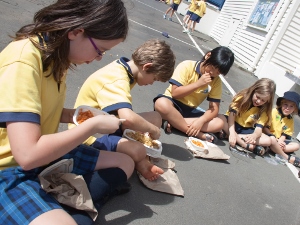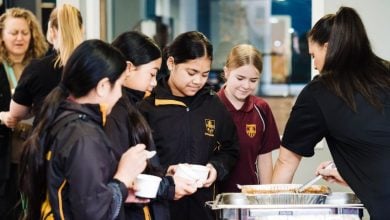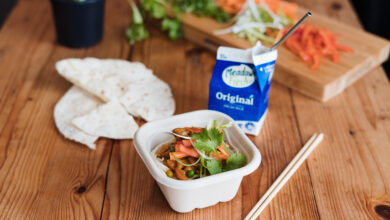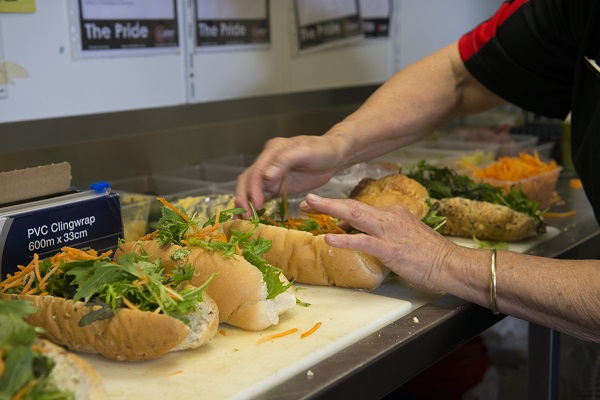School lunches go online

 Online shopping is fast becoming the new normal for many New Zealanders, according to recent research, so it’s probably not surprising that purchasing school lunches online is being added to the list. As parents, teachers, school administrators and pupils realise the ease and convenience of ordering lunches online, the service is taking off.
Online shopping is fast becoming the new normal for many New Zealanders, according to recent research, so it’s probably not surprising that purchasing school lunches online is being added to the list. As parents, teachers, school administrators and pupils realise the ease and convenience of ordering lunches online, the service is taking off.
Several online lunch ordering companies have been established over the last few years, offering different food choices and slight variations in the way the online service operates. Fundamentally, they all work the same way, though, with customers placing their orders online, the organisation passing the orders on to the food suppliers, and the suppliers then responsible for delivering the food to the schools. The orders are bagged and labelled with the children’s names, avoiding any confusion. To pay, customers have money in credit and are alerted if the balance is insufficient when they order so they can top up.
The selection of food items varies between providers and ranges from snacks and drinks through to sandwiches, pies and hot dishes, with some companies having more of a focus on healthy food choices. The service can also be used as a fundraiser with a percentage of sales going to the school.
Hawkes Bay-based lunchonline began towards the end of 2010 after a trial run with one school and one provider showed it would work, says owner David Chapman. “It really started after a number of schools approached a bakery about providing lunches, but they didn’t want to handle the administrative side of things. I saw it as a great opportunity to develop a system whereby many providers could supply school lunches. That’s how lunchonline was born.
“Our three partners, a software company, the lunch provider and a business consultant developed the system. We’re all parents, so we understood it from the parents’ point of view, what we’d like.” The company now provides the service from Auckland to Dunedin, with approximately 60 schools and 20 providers involved “We’re targeting schools decile four and above,” Mr Chapman says. “The uptake in decile one to three is relatively low, but if a low decile school comes to us and asks for a lunch service and there’s a provider in the locality, we’ll talk to them.”
Response to the service varies. For example, at one school where there was no lunch available, the parents were very keen to see lunchonline being introduced, Mr Chapman says. “We approached the school, but they said, no. On the other hand, one Christchurch school was very keen and thanks to the encouragement of a PTA member, five out of the seven schools in the cluster are doing it.”
The service is available Monday to Friday, though most schools use it on two or three days a week, he says. Friday is the most popular day, while Wednesday is also a good day. Choices include bakery items such as sandwiches, rolls, sausage rolls, pies and muffins, sushi and Subway sandwiches, with one provider supplying per day. “Some schools didn’t want pies being ordered, but we sought advice from a nutritionist, who said that there was nothing wrong with children having a pie once a week, it’s more about balanced meals, and if kids are eating healthy and are active, it’s fine. Most schools recognise that, but there are a couple that won’t allow treats, such as lolly slice, though a scone or a muffin is OK.”
The providers are paid weekly, and the advantage for them is, because they are making to order there is no wastage, Mr Chapman says. “The benefit for the schools with online lunch ordering is that there’s nothing for them to do, and parents don’t have to worry about children losing their lunch money.” For Sandra Finlay of ezlunch, setting up the online service was “quite personal”. “My daughter had intolerance to some foods, which got me looking in more detail at what is in our everyday foods. There’s a surprising amount of additives and preservatives that I believe result in a lot of food intolerances. At my children’s school the typical tuck shop fare was not what I would feel comfortable giving to my own children regularly. “There wasn’t the support for parents who wanted a convenient alternative with real food. So I decided what was needed was giving children real food with fresh ingredients in a way that was convenient. “Everyone’s working and busy and things can be difficult so it needed to be an online service so people could order any time. At ezlunch we take orders right up to 9am on the day the lunch is required.
“Children can have their main meal at lunchtime and our food items are very much about this concept. A lot of European countries have their main meal in the middle of the day, and children need good nutrition at lunchtime so they can learn in the afternoon.
“Schools that join the ezlunch service advise the parents that it’s available and we find a good local café to supply the food. We work with the Heart Foundation’s fuelled4life team to ensure our menus are top notch and we can provide good information to parents and students for making healthy choices from our menus,” Ms Finlay says. “The food needs to be made fresh. The hot items include lasagne, spaghetti Bolognese, beef and bean pasta bake, low-fat butter chicken, ribbon noodles with chicken and veges and fried rice. Sushi is also a big seller. The quality of the food is different from what’s available at the dairy, and that’s reflected in the price, but we try really hard to keep the prices at a good level.”
The ezlunch service is available nationwide and currently there are 50 schools involved around New Zealand, and about 12 providers, with most of the providers servicing more than one school. Ease of payment is another key factor with online ordering, Mrs Finlay says. “Today, people expect to purchase things online, so the service is more about the parents than the children. Schools are the last bastion of cheque book payment, but online purchasing suits people’s lifestyle and schools need to be on to that.” The ezlunch system uses the same software as the company’s Kindo online service, which several schools are using for collecting donations now and can be applied to a range of online sales and services that schools and parents use, Ms Finlay says.
The most recent arrival on the online lunch scene is thelunchboxclub, which was launched in July 2013 in two Whangarei schools, and is now available in Tauranga/Mt Maunganui as well. Owner Janine Collins says she began to formulate the idea over the previous summer holidays as she felt schools needed to take more responsibility for the message they were sending children via their lunch services. “I often felt the food was more like the complete opposite of the messages taught in the classroom. And seeing the constant notices in the school newsletter asking for parent volunteers for the school lunch service, I figured there must be a way to incorporate technology to not only reduce the involvement of school administrators and volunteers, but also to use a lunch service to help reinforce a healthy eating message. “With processed food available everywhere I felt it was a great opportunity to help kids realise that ‘real food’ doesn’t come in packets.
“The lunchboxclub uses trusted local businesses to create, prepare and supply the food,” Ms Collins says. “We offer a range of food items from ‘Green Light’ fresh and real food items to ‘Red Light’ treat items. We realise families use their lunch service for different reasons so we aim to keep them all happy. We can work with schools to tailor their menu and they can limit the treats if that’s part of their policy. “The most popular items are sushi, mac n cheese, gluten-free nachos, chicken wraps, ham and pinwheel sandwiches, as well as some of the more treat items like handmade pies and chocolate brownies. “Each school’s menu can be completely different, so this allows for local tastes and preferences. We have a base menu from which suppliers choose a certain number of items to carry and then fill this out with their own local specialty items. The base menu offers something for everyone, whether Paleo, Primal, raw, sugar free or Heart Foundation approved.”
In developing the service, Ms Collins spoke to DHB nutritionists and public health nurses, particularly those who work in the paedeatric sector and also liaised with the Heart Foundation. “I also researched what was used internationally and ultimately created our ‘Traffic Light Food Guide’ with the help of a nutritionist from Auckland who created and consults on school meal services in Australia and the UK.” Ms Collins says the uptake has been great, although there have been some issues with technology usage in Whangarei. “We have evolved and consolidated our service to meet the market and now we are confident we can take bigger steps.









